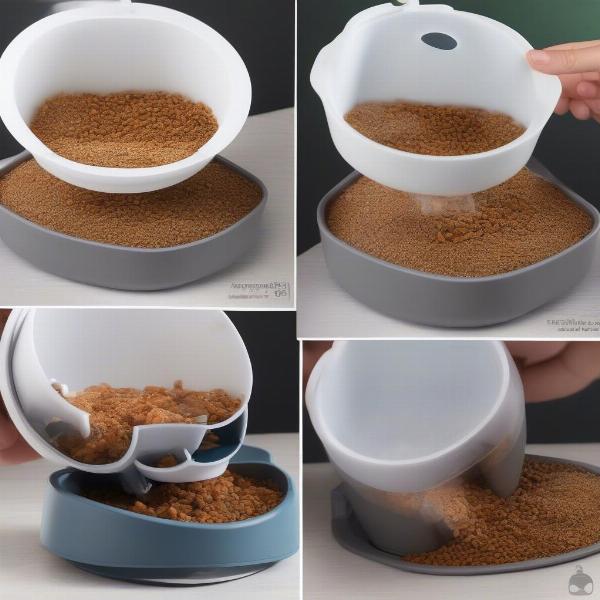Slow feeder inserts for dogs are a simple yet effective solution for pups who inhale their food faster than a speeding bullet. These ingenious devices fit snugly inside your dog’s existing bowl, creating a maze-like obstacle course that forces them to slow down and savor their meals. Using a slow feeder insert can prevent a range of digestive issues and promote healthier eating habits. But with so many options available, how do you choose the right one for your furry friend? This guide will cover everything you need to know about slow feeder inserts for dogs, from their benefits to choosing the perfect one.
The Benefits of Using a Slow Feeder Insert for Dogs
Why should you consider a slow feeder insert for your dog? There are several compelling reasons, all related to improved health and well-being. For dogs who gulp their food, a slow feeder insert can be a game-changer. It transforms mealtime from a frantic race to a more relaxed and enjoyable experience.
- Improved Digestion: Slowing down eating allows for proper chewing and saliva production, which aids in digestion. This can prevent issues like bloating, vomiting, and regurgitation.
- Weight Management: By extending mealtimes, slow feeders help dogs feel fuller for longer, potentially reducing overeating and promoting a healthy weight.
- Mental Stimulation: Navigating the obstacles in the slow feeder provides a mild form of mental enrichment, keeping your dog engaged and entertained during mealtimes.
- Reduced Risk of Bloat: Bloat, or Gastric Dilatation-Volvulus (GDV), is a life-threatening condition that can occur when dogs eat too quickly. Slow feeders significantly reduce this risk.
Choosing the Right Slow Feeder Insert
Selecting the right slow feeder insert depends on several factors, including your dog’s breed, size, eating habits, and the type of food they consume.
- Size and Breed: Choose an insert that is appropriately sized for your dog’s breed and mouth size. A small insert in a large bowl might not slow down a large dog, while a large insert in a small bowl could frustrate a small dog.
- Material: Slow feeder inserts are available in various materials, including plastic, silicone, and stainless steel. Consider durability, ease of cleaning, and your dog’s chewing habits. slow dog feeder insert
- Design: The design of the insert dictates the level of difficulty. Some inserts have simple raised patterns, while others feature more complex mazes. Start with a simpler design and progress to a more challenging one if needed.
- Food Type: The type of food you feed your dog can also influence your choice. Some inserts are better suited for dry kibble, while others work well with wet or raw food.
How to Introduce a Slow Feeder Insert to Your Dog
Introducing a slow feeder insert should be a gradual process to ensure your dog accepts it positively. Start by placing a small amount of food on top of the insert. Once your dog is comfortable with that, gradually increase the amount of food placed within the insert itself. Be patient and encouraging, and offer positive reinforcement like praise or treats. anti gulp dog bowl
 Introducing a Slow Feeder Insert to a Dog
Introducing a Slow Feeder Insert to a Dog
Cleaning and Maintenance of Slow Feeder Inserts
Most slow feeder inserts are dishwasher safe, making cleaning a breeze. However, always check the manufacturer’s instructions for specific cleaning recommendations. Regular cleaning prevents the build-up of bacteria and keeps your dog’s feeding area hygienic. slow feeder bowl for dogs
Are Slow Feeder Inserts Right for All Dogs?
While slow feeder inserts are beneficial for many dogs, they might not be suitable for all. Dogs with certain medical conditions, such as megaesophagus, might require different feeding strategies. Consult with your veterinarian if you have any concerns about whether a slow feeder is appropriate for your dog.
Conclusion
Slow feeder inserts offer a simple and effective way to improve your dog’s eating habits and overall health. By slowing down mealtimes, these inserts can prevent digestive issues, promote weight management, and provide mental stimulation. With careful consideration of your dog’s individual needs and a gradual introduction, a slow feeder insert can be a valuable addition to your dog’s mealtime routine. Remember to choose an insert that is appropriately sized, made of durable material, and designed to suit your dog’s eating style. dog slow feeder insert
FAQ
- Are slow feeder inserts safe for puppies? Yes, slow feeders can be beneficial for puppies, helping them develop healthy eating habits from a young age.
- Can I use a slow feeder insert with wet food? Some slow feeder inserts are designed for wet food, while others are better suited for dry kibble. Check the product description before purchasing.
- What if my dog refuses to eat from a slow feeder insert? Try introducing the insert gradually and offering positive reinforcement. If your dog still resists, consult with a veterinarian or professional dog trainer.
- How often should I clean the slow feeder insert? Clean the insert after each use, either by hand washing or in the dishwasher (if dishwasher safe).
- Can a slow feeder insert prevent bloat completely? While slow feeders significantly reduce the risk of bloat, they cannot eliminate it entirely.
slow feeder stainless steel dog bowls
About ILM Dog
ILM Dog is your trusted resource for expert advice on dog care and wellbeing. We provide comprehensive information on dog breeds, health, training, nutrition, grooming, and much more. Whether you’re a seasoned dog owner or just starting your journey, ILM Dog offers valuable insights and practical tips to help you provide the best possible care for your furry companion. Contact us for personalized advice at [email protected] or +44 20-3965-8624. We look forward to connecting with you!